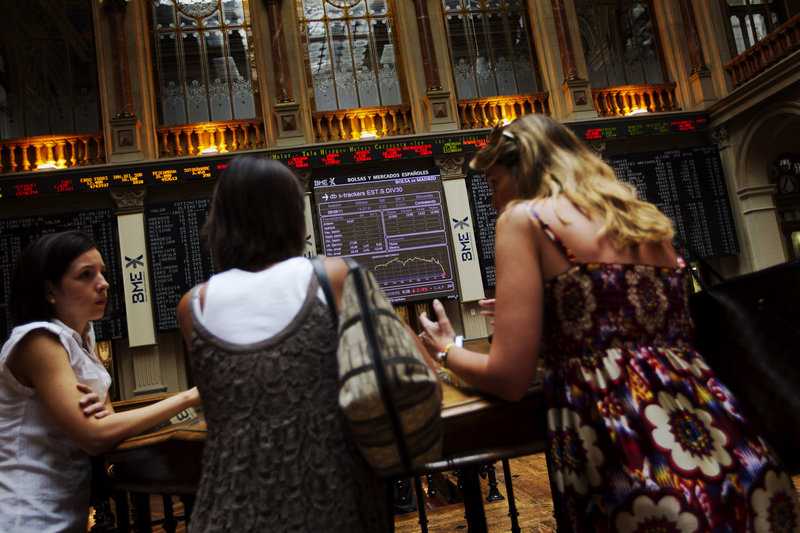BERLIN – As investors dumped stocks Friday on both sides of the Atlantic, a growing suspicion that Europe’s banks are on shaky ground offered more evidence that the struggling global economic recovery is in trouble.
The increasing mistrust of Europe’s banks is threatening to drag down the continent’s already sluggish economy and prompting new worries for American financial firms that do business with their European counterparts.
The concerns about the health of Europe’s financial firms are making it harder for them to raise money. In turn, they are under pressure to charge more for loans they offer to businesses and consumers on the continent. The resulting credit crunch, though not nearly as severe, has echoes of three years ago when Wall Street’s meltdown prompted fearful banks and businesses in the United States and elsewhere to stop lending each other money, choking off the economy’s lifeblood.
The trouble in the European banking sector comes at a time when policymakers are already struggling to address the continent’s spreading debt crisis and stalling economic growth. New indicators out this week, for instance, showed that growth in Germany, long the region’s economic dynamo, had slowed nearly to a standstill.
Deutsche Bank analyst Matt Spick said that perceived weaknesses in European banks, coupled with the economic slowdown, is creating a “toxic funding crisis” that could leave the financial firms strapped for cash and forced to curb lending.
In European trading, bank stocks continued to drop Friday, after even steeper losses a day earlier.
Germany’s Deutsche Bank lost 7.5 percent in the past two days, and Britain’s RBS was off more than 16 percent.
More broadly, the Stoxx 50, an index of blue-chip companies in the 17-nation euro zone, finished Friday down 2.15 percent. In the United States, the Dow Jones industrial average was off 1.6 percent for the day while the Standard & Poor’s 500, a wider market index, lost 1.5 percent.
At the heart of the problem are hundreds of billions of dollars in government bonds issued by heavily indebted countries from Ireland to Italy and bought by banks throughout the 17-nation euro currency zone.
At the time of purchase, the banks viewed the bonds as virtually risk-free investments. The banks were not required to set aside any money as a buffer in case of losses on the bonds and considered them easy to use as collateral in raising other funds.
But the government bonds have turned out to be Europe’s version of subprime mortgage loans. No one is sure who owns them or how many they own.
And amid Europe’s spreading debt crisis, no one knows what the bonds will be worth. Holders of Greek government bonds are already being asked to accept a 21 percent cut in the value of their holdings as part of an international effort to bail out Greece. Investors now worry they could be asked to accept a similar haircut on the more popular bonds of larger countries such as Italy and Spain if they also need to be rescued.
Any crisis in the European banking system could quickly buffet the United States. If those banks run into trouble, it could affect major U.S. money-market funds, considered a safe place for investors to put cash. Major European banks have also been active investors and lenders in the U.S. economy.
Although the situation is grim, financial analysts note that no bank has failed nor loans defaulted. So far, there is little evidence of the type of fast-moving collapse in lending that threatened the financial system in 2008. If anything, steps taken since then have minimized the risk, including the offer by the European Central Bank to make dollar loans to banks to ensure they have the funding they need.
But there is evidence that the economy is already being affected by the constraints banks face on borrowing, as well as by the steps they have taken to restructure themselves after the last financial meltdown.
To gird themselves, banks have increased their capital buffers in case of losses. Some banks have been closed, merged or recapitalized with taxpayer help. Failing lines of business have been hived off into “bad banks,” allowing the healthier parts to continue their activities. Key elements of the German banking system, for instance, are still being revamped and recapitalized, nearly three years after the depths of the last financial crisis.
Charles Wyplosz, professor of economics at the Graduate Institute in Geneva, warned that he saw parallels with 1980s-era Japan, where so-called zombie banks weighed down with bad investments tried to improve their financial standing by simply withholding new loans.
“In some respects, we have that in Europe,” Wyplosz said. “The banks are not well prepared for what could happen next, so their natural reaction is to be extra cautious.”
A recent stress test of 90 European banks found, for the most part, that they were able to raise capital.
But they also remain vulnerable. The test showed they are tens of billions of dollars short of what would be needed to safely steer through another economic downturn.Although the situation is grim, financial analysts note that no bank has failed nor loans defaulted.
Copy the Story Link
Send questions/comments to the editors.



Success. Please wait for the page to reload. If the page does not reload within 5 seconds, please refresh the page.
Enter your email and password to access comments.
Hi, to comment on stories you must . This profile is in addition to your subscription and website login.
Already have a commenting profile? .
Invalid username/password.
Please check your email to confirm and complete your registration.
Only subscribers are eligible to post comments. Please subscribe or login first for digital access. Here’s why.
Use the form below to reset your password. When you've submitted your account email, we will send an email with a reset code.